Argentina Home Appliances Market Size
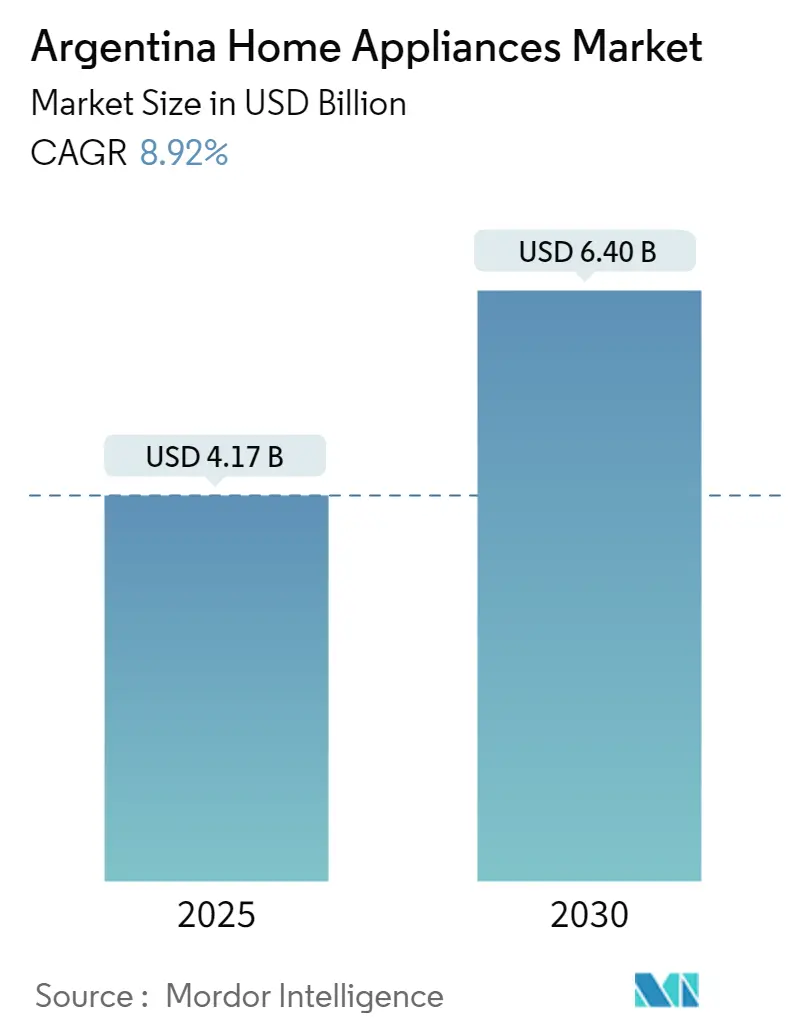
| Study Period | 2020 - 2030 |
| Base Year For Estimation | 2024 |
| Forecast Data Period | 2025 - 2030 |
| Market Size (2025) | USD 4.17 Billion |
| Market Size (2030) | USD 6.40 Billion |
| CAGR (2025 - 2030) | 8.92 % |
| Market Concentration | Medium |
Major Players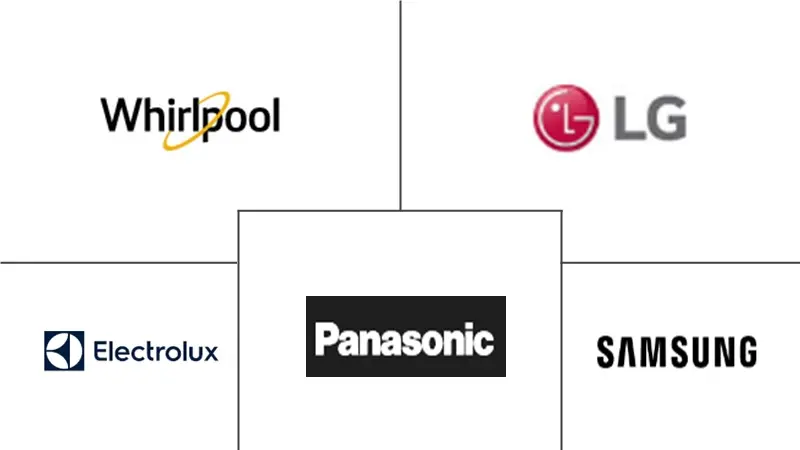
*Disclaimer: Major Players sorted in no particular order |
Argentina Home Appliances Market Analysis
The Argentina Home Appliances Market size is estimated at USD 4.17 billion in 2025, and is expected to reach USD 6.40 billion by 2030, at a CAGR of 8.92% during the forecast period (2025-2030).
The growth of the freezer segment can be attributed to the improvement in the standard of living of consumers and the growing awareness of the benefits of using home appliances. The washing machine segment is expected to grow at a fast pace over the coming years. This is due to factors such as increasing disposable income and consumers' preference for energy-saving products.
The household appliances market is growing due to the growing trend of smart and connected appliances. This trend is expected to further propel the market growth. In urban areas, there is a growing demand for products like LED TV, laptop, split AC and beauty and wellness products. In rural areas, the demand for durables such as refrigerators and other home appliances is expected to grow. Technological innovation, innovative products and Lifestyle products are major growth drivers for the market.
Despite the growing penetration of e-commerce and the growing percentage of customers willing to spend money online, especially among younger generations, consumers continue to prefer to shop in physical stores or outlets. Online retail channels are also growing rapidly, with both online retailers and manufacturers building their online footprint.
Argentina Home Appliances Market Trends
Convenience Products Leading the Market
The convenience that the product brings to the consumer's life is making them opt for it. Small home appliances come with a shorter lifespan, which makes it easy for the consumer to replace or exchange them for a newer model. The sales volume of coffee machines almost doubled in the study period and was followed by small kitchen appliances. Customer choices are transitioning. They are shifting to innovative and energy-efficient products for their daily utilization. Products like egg cookers are the best example that explains the increasing interest among manufacturers to focus more on automating people's daily activities by taking a load off their shoulders. They also improve accuracy and bring innovation by producing multi-utility products rather than single-utility products.
The home appliances market in Argentina is on the rise, driven by population growth, urbanization, rising incomes, and shifting consumer lifestyles. This market encompasses a diverse array of products, including refrigerators, washing machines, air conditioners, ovens, microwaves, vacuum cleaners, and small kitchen appliances. Argentine consumers, in their appliance purchases, prioritize attributes like energy efficiency, durability, and affordability. Notably, there's a surging demand for energy-efficient appliances, aiding in electricity conservation and cost reduction. Furthermore, consumers are increasingly drawn to appliances boasting innovative features, contemporary designs, and cutting-edge technologies. The Argentine home appliances market is segmented into various product categories, each catering to distinct household needs. These categories include major appliances (e.g., refrigerators, washing machines, dishwashers), small appliances (e.g., blenders, coffee makers, toasters), and air conditioning and heating systems. In this fiercely competitive landscape, both domestic players like Longvie, Patrick, and Liliana, and international giants such as Whirlpool, Electrolux, Samsung, and Philips vie for market dominance. The competition hinges on factors like product quality, brand reputation, pricing, and robust distribution networks.
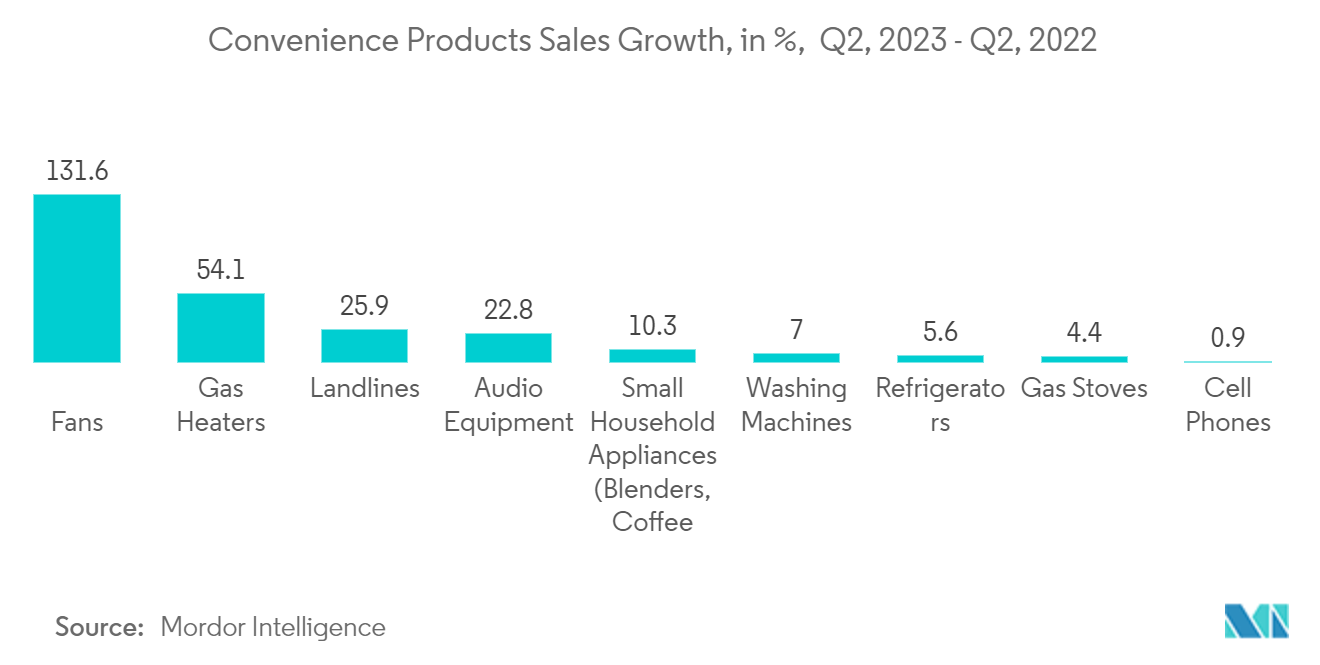
Store-based Purchases Holding Major Sales Volume
Even though the e-commerce penetration and percentage of customers who are willing to spend on online shopping are increasing, especially among the younger generations, consumers are still preferring to buy their products via stores or outlets only. The factors that are driving these sales are the after-sales service and delivery of the purchased product. It is observed that online sales platforms are failing to reach average customers who do not have their own logistics services.
The shipping charges for the majority of the products are almost the same as the price of the product they purchased. The fact that most customers from this region prefer to repair their products rather than replace them is making them choose nearby stores for their desired purchases. All these factors are affecting the Argentine purchasing decision, thus increasing store-based purchases.
In Argentina, home appliances are retailed through a diverse set of channels, including specialty stores, department stores, hypermarkets, online platforms, and dedicated dealerships. Online retail, in particular, has witnessed a surge, enabling consumers to conveniently compare prices and make purchases. The Argentine government is considering policy measures to encourage the adoption of energy-efficient appliances and curb energy consumption. These initiatives might involve energy efficiency labeling, appliance regulations, and financial incentives like rebates or tax credits. For Argentine consumers, after-sales services, encompassing warranties, maintenance, and repairs, hold significant sway in their appliance choices. Manufacturers and retailers, cognizant of this, often extend warranties and service contracts to bolster customer satisfaction. However, the home appliances market in Argentina grapples with challenges like economic volatility, currency fluctuations, inflation, and evolving consumer spending habits. To stay competitive and foster growth, industry players must adeptly respond to market dynamics and evolving consumer preferences.
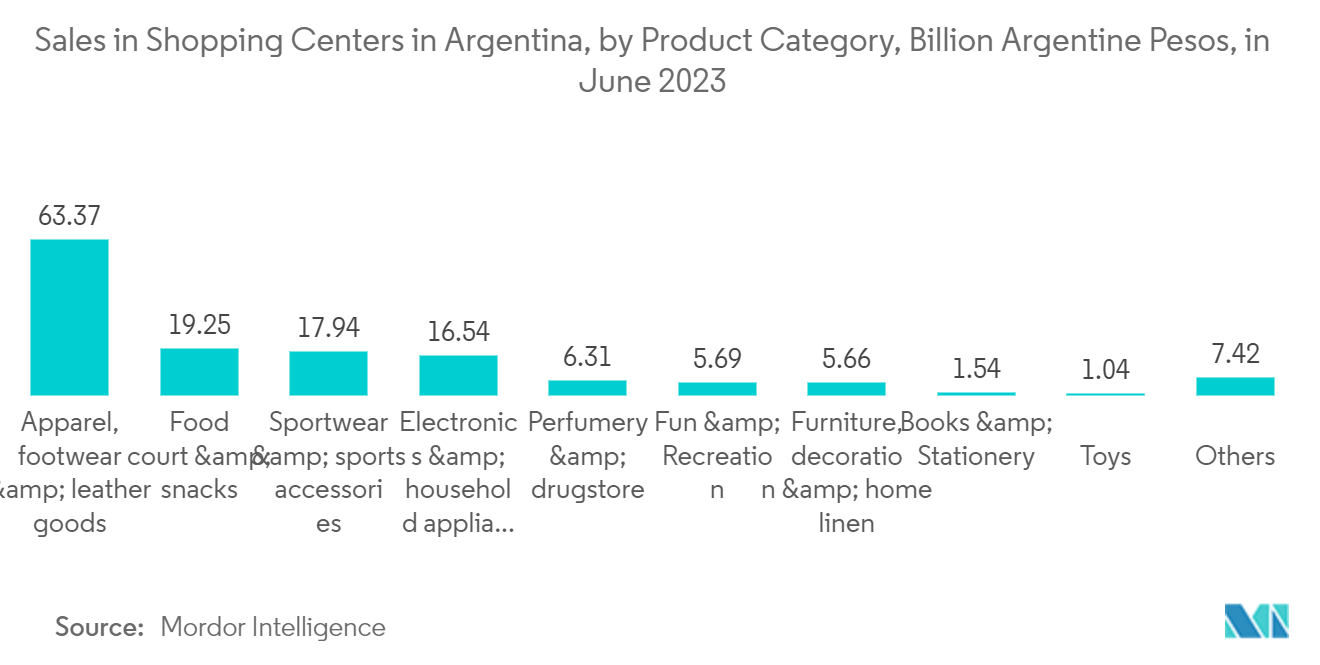
Argentina Home Appliances Industry Overview
The report covers major international players operating in the Argentine home appliance market. Technology and innovation are driving the market across the world. All the major players are coming up with innovations and investing heavily in their R&D facilities. The Argentine market welcomes newcomers who can make a difference in the way the product range is offered. The market has a lot of room for innovation in the way it operates. The market also holds great scope for online retailers to penetrate.
Argentina Home Appliances Market Leaders
-
Whirlpool Corporation
-
Electrolux AB
-
LG Electronics
-
Samsung Electronics
-
Panasonic Corporation
*Disclaimer: Major Players sorted in no particular order
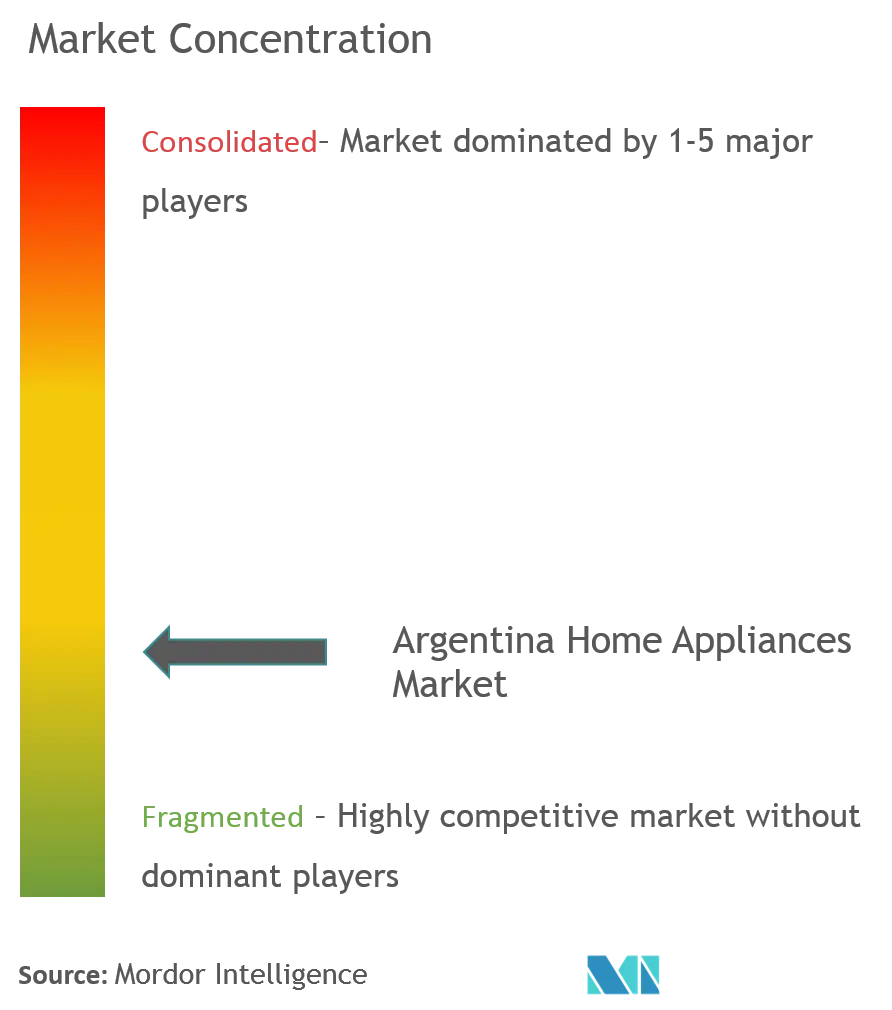
Argentina Home Appliances Market News
- In March 2024, LG announced a USD 60 million investment in Bear Robotics, a Silicon Valley-based startup specializing in service robots. This investment reflects LG's commitment to fostering robotics as a pivotal driver of its growth strategy.
- In March 2024, Frávega, a top player in the household appliances and technology sector, announced its status as an authorized sales channel for Starlink in Argentina.
Argentina Home Appliances Market Report - Table of Contents
1. INTRODUCTION
1.1 Study Assumptions and Market Definition
1.2 Scope of the Study
2. RESEARCH METHODOLOGY
3. EXECUTIVE SUMMARY
4. MARKET DYNAMICS AND INSIGHTS
4.1 Market Overview
4.2 Market Drivers
4.3 Market Restraints
4.4 Industry Value Chain Analysis
4.5 Industry Attractiveness - Porter's Five Forces Analysis
4.5.1 Bargaining Power of Buyers
4.5.2 Bargaining Power of Suppliers
4.5.3 Threat of New Entrants
4.5.4 Threat of Substitutes
4.5.5 Intensity of Competitive Rivalry
4.6 Insights of Technology Innovations in the Market
4.7 Impact of COVID-19 on the Market
5. MARKET SEGMENTATION
5.1 Major Appliances
5.1.1 Refrigerators
5.1.2 Freezers
5.1.3 Dishwashing Machines
5.1.4 Washing Machines
5.1.5 Cookers and Ovens
5.2 Small Appliances
5.2.1 Vacuum Cleaners
5.2.2 Small Kitchen Appliances
5.2.3 Hair Clippers
5.2.4 Irons
5.2.5 Toasters
5.2.6 Grills and Roasters
5.2.7 Hair Dryers
5.2.8 Other Small Appliances
5.3 Distribution Channel
5.3.1 Supermarkets and Hypermarkets
5.3.2 Specialty Stores
5.3.3 E-Commerce
5.3.4 Other Distribution Channels
6. COMPETITIVE LANDSCAPE
6.1 Market Concentration Overview
6.2 Company Profiles
6.2.1 Whirlpool Corporation
6.2.2 Electrolux AB
6.2.3 LG Electronics
6.2.4 Samsung Electronics
6.2.5 Panasonic Corporation
6.2.6 Haier Electronics Group Co. Ltd,
6.2.7 BSH Hausgeräte GmbH
6.2.8 Arcelik AS
6.2.9 Gorenje Group
- *List Not Exhaustive
7. MARKET OPPORTUNITIES AND FUTURE TRENDS
8. DISCLAIMER AND ABOUT US
Argentina Home Appliances Industry Segmentation
Home appliances include electrical or mechanical devices used in a household. They assist in household functions such as cleaning, cooking, and food preservation, among other activities.
The Argentine home appliances market is segmented by major appliances, small appliances, and distribution channels. By major appliances, the market is sub-segmented into refrigerators, freezers, dishwashing machines, washing machines, cooks, and ovens. By small appliances, the market is sub-segmented into vacuum cleaners, small kitchen appliances, hair clippers and hair dryers, irons, toasters, grills and roasters, and other small appliances. By distribution channels, the market is sub-segmented into supermarkets and hypermarkets, specialty stores, e-commerce, and other distribution channels.
The report offers market size and forecasts for the Argentina home appliance market in terms of value (USD) for all the above segments.
| Major Appliances | |
| Refrigerators | |
| Freezers | |
| Dishwashing Machines | |
| Washing Machines | |
| Cookers and Ovens |
| Small Appliances | |
| Vacuum Cleaners | |
| Small Kitchen Appliances | |
| Hair Clippers | |
| Irons | |
| Toasters | |
| Grills and Roasters | |
| Hair Dryers | |
| Other Small Appliances |
| Distribution Channel | |
| Supermarkets and Hypermarkets | |
| Specialty Stores | |
| E-Commerce | |
| Other Distribution Channels |
Argentina Home Appliances Market Research FAQs
How big is the Argentina Home Appliances Market?
The Argentina Home Appliances Market size is expected to reach USD 4.17 billion in 2025 and grow at a CAGR of 8.92% to reach USD 6.40 billion by 2030.
What is the current Argentina Home Appliances Market size?
In 2025, the Argentina Home Appliances Market size is expected to reach USD 4.17 billion.
Who are the key players in Argentina Home Appliances Market?
Whirlpool Corporation, Electrolux AB, LG Electronics, Samsung Electronics and Panasonic Corporation are the major companies operating in the Argentina Home Appliances Market.
What years does this Argentina Home Appliances Market cover, and what was the market size in 2024?
In 2024, the Argentina Home Appliances Market size was estimated at USD 3.80 billion. The report covers the Argentina Home Appliances Market historical market size for years: 2020, 2021, 2022, 2023 and 2024. The report also forecasts the Argentina Home Appliances Market size for years: 2025, 2026, 2027, 2028, 2029 and 2030.
Argentina Home Appliances Industry Report
Statistics for the 2025 Argentina Home Appliances market share, size and revenue growth rate, created by Mordor Intelligence™ Industry Reports. Argentina Home Appliances analysis includes a market forecast outlook for 2025 to 2030 and historical overview. Get a sample of this industry analysis as a free report PDF download.



